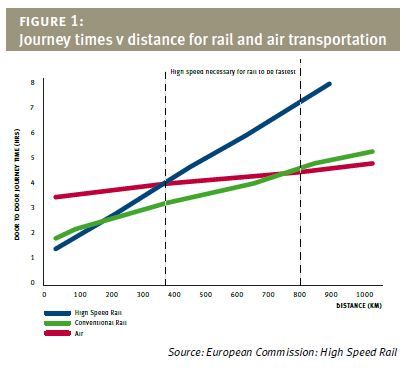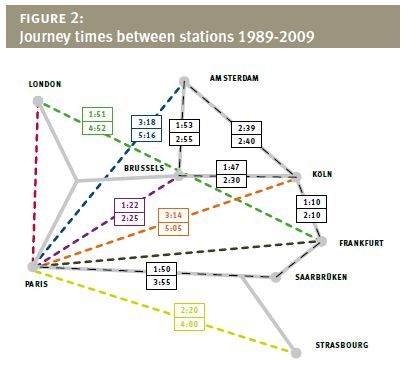In Europe, much research has been undertaken to explore how air and rail services may compete with each other, as well as complement each other.
For many years, Steer Davies Gleave has been at the center of investigating the main drivers and impacts of the competition between air services and high speed and conventional rail services. There are also examples where these rail services can provide complementary services to airports which are experiencing capacity constraints.
In Europe, we undertook a study on these issues for the European Commission, Air and rail competition and complementarity (August 2006), and more recently, the Commission has also updated its position by publishing a document entitled High speed Europe: a sustainable link between citizens (2010). Our study was based on eight major air-rail routes across Europe which drew up three main conclusions:
- Market share
Market share of air/rail is a function of rail journey time and there appeared to be evidence of a switching point if the rail journey was less than four hours long, as illustrated in Figure 1. In addition, market share was impacted by the extent of price competition – particularly from low cost airlines – which enables air to retain a higher market share than it might otherwise.
- Other factors
Of lower importance were factors such as reliability of the rail services and the access to rail terminals from the main catchment areas of the population demand.
- The future
With increasing environmental pressures on airlines, and a number of new build or enhanced build high speed lines being built (or already built) in Europe, the expectation was that rail would increase its market share on each of these key eight routes. The reductions in rail trip times enabling this change have recently been reported in the graphic below.
In Frankfurt and Paris, there have been attempts to establish complementary rail services, feeding short-haul domestic traffic to the airports. The results have been mixed, as security concerns and high operating costs have caused difficulties.
As a result, these locations remain the only complementary, integrated services provided in Europe by rail to air.
In principle, high speed rail services can provide a convenient alternative to air services where the travel time by train is less than 3-4 hours. Furthermore, the environmental pressures placed on the aviation industry and runway capacity constraints mean a number of new HSR networks are being built in Italy, Spain, Poland, Portugal, UK, and France. Our recent report, Potential for modal shift from air to rail in the UK (2009), found that rail can be competitive with air for specific routes, but for long distances, with trips over 5-6 hours, it couldn’t be an effective competitor.
The results of these studies can provide a good basis for applying to the unique and specific circumstances facing North
America and its decisions about where to locate high speed rail services.

